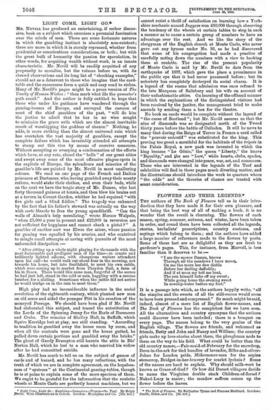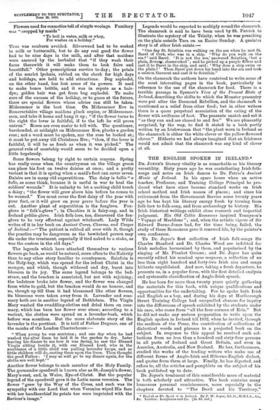FLOWERS AND THEIR LEGENDS.*
THE authors of The Book of Flowers tell us in their intro-
duction that they have made it for their own pleasure, and that being the best way of all of making a book, it is no wonder that the result is charming. The flowers of each season, spring, summer, autumn, and winter, have been taken in order, and round them have been collected all the legends, stories, herbalists' prescriptions, country customs, and sayings which belong to them ; and the authors have added a large number of references made to the flowers by poets.
Some of these last are as delightful as they are fresh to gardener's pages. This, for instance, from Marvell, is less familiar than it deserves to be :— " I am the mower Damon, known
Through all the meadows I have mown.
On me the morn her dew distils Before her darling daffodils; And if at noon my toil me heat, The sun himself licks off my sweat; While going home the evening sweet In cowslip-water bathes my feet."
It is a passage into which, as the authors happily write, "all the simples and the sweets of all the still-rooms would seem
to have been pressed and compressed." So much might be said, indeed, almost of a mere list of English flower-names, and
The Book of Flowers has the completest list we have seen. All the alternatives and country synonyms that the authors
could discover have been included; there is a bouquet on every page. The names belong to the very genius of the English village. The flowers are friends, and welcomed as friends, Betty and John and Nancy and William; the country girls make up love-stories about them, the ploughman nods to them on the way to his field. What could be better than the old country names,—Fair-maid-of-February for the snowdrop, Dove-in-the-ark for tied bundles of lavender, Silks-and-silver- Johns for London pride, Midsummer-men for the orpine stonecrop, Bridget-in-her-bravery for scarlet lychnis P Some of the names are hard to explain. Why should milk-wort be known as Grace-of-God P Or how did Dorset villagers decide to name the Virginian double stock Children-of-Israel ? Naked-Lucy is easier ; the meadow saffron comes up the flower before the leaves. Flowers used for cosmetics tell of simple wooings. Fumitory was "cropped by maids" "To boil in water, milk or whey, For washes on a holiday."
Thus was sunburn avoided. Silverweed had to be soaked
in milk or buttermilk, but to do any real good the flower had to be nine days in the milk, and after that maidens were assured by the herbalist that "if they wash their faces therewith it will make them to look faire and beautifull." Other prescriptions survive to-day; the petals of the scarlet lychnis, rubbed on the cheek for high days and holidays, are held to add attractions. Bog asphodel, on the other hand, has lost some of its powers. It used to make bones brittle, and it was in repute as a hair- dye; golden hair was got from bog asphodel. To make sure of the success of the holiday, or to guess at the future, there are special flowers whose advice can still be taken. Midsummer is the best time. On Midsummer Eve in Somersetshire village maidens pluck orpine, or Midsummer. men, and take it home and hang it up ; "if the flower turns to the right the lover is faithful, if to the left he will prove untrue." Roses are even easier to tell with. The questioner, bareheaded, at midnight on Midsummer Eve, plucks a garden rose; not a word must be spoken, nor the rose be looked at; it must be put away till Christmas Eve; "then, if the lover is faithful, it will be as fresh as when it was picked." The general rule of courtship would seem to be decided upon a little hopelessly.
Some flowers belong by right to certain seasons. Spring bas really come when the countryman on the village green can place his foot on twelve daisies at once; and a pretty variant is that it is spring when a maid's foot can cover seven.
Daisies are in many old superstitions. The daisy is bells " a bello, as some think, because it is useful in war to heal the soldiers' wounds." It is unlucky to let a sucking child touch a daisy; "the flower will grow above him before he comes to be weaned." You must cover the first daisy of the year with your foot, or it will grow on your grave before the year is out. Another plant of superstition is the foxglove. Fox- glove is " folk's-glove "; in Cheshire it is fairy-cap, and in Ireland goblin-glove. Irish folk-lore, too, discovered the fox- glove to be very effectual against witchcraft. Lady Wilde
writes of it in her book on Ancient Cures, Charms, and Usages of Ireland :—" The patient is rubbed all over with it, though
the practice may be dangerous as the bewitched person may die under the treatment, especially if tied naked to a stake, as was the custom in the old days."
The legends which have attached themselves to various flowers go back, as would be natural, more often to the Nativity than to any other story familiar to countrymen. Sainfoin is the Holy-hay, which was spread for the infant Christ in the manger, and which, though withered and dry, burst into blossom in its joy. The same legend belongs to the bed- straw, and the bracken is associated, but not with rejoicing; the bedstraw broke into flower, and the flower was changed from white to gold, but the bracken would do no honour, and so, though up till then it had blossomed like other flowers, its blossoms were taken away from it. Lavender and rose- mary both are in another legend of Bethlehem. The Virgin Mary washed the swaddling-clothes and dried them on rose- mary, which has been her flower ever since; according to a variant, the clothes were spread on a lavender-bush, which before was scentless. But the more elaborate story of the lavender is the prettiest. It is told of Father Dugmer, one of the monks of the London Charterhouse :-
"When young he was sacristan ; and one day when he had washed the altar linen he laid it in the garden to dry. Later leaving his dinner to see how it was faring, he saw the Blessed Virgin sitting beside it, with our Blessed Lord, who in the semblance of a little child was pulling lavender knops, and as little children will do, casting them upon the linen. Then thought the good Father I may as well go to my dinner again, for the cloths are well kept."
Another flower belongs to each member of the Holy Family The germander speedwell is known also as St.-Joseph's-flower, Mary's-rest, and, in Wales, Eye-of-Christ. But the popular legend of the speedwell gave it its Latin name veronica. The flower "grew by the Way of the Cross, and such was its sympathy with our Lord that when Veronica wiped His face with her handkerchief its petals too were imprinted with the Saviour's image."
Legends would be expected to multiply round the shamrock. The shamrock is said to have been used by St. Patrick to illustrate the mystery of the Trinity, when be was preaching on the plain outside Tara on an Easter Sunday. A quainter story is of other Irish saints "One day St. Sciuthin was walking on the sea when he met St. Barth of Cork, who was in a ship. Why do you walk on the sea P said Barth. It is not the sea,' answered Sciuthin but a plain, .z .flowew, shamrocked ' ; and he picked up a purple flower and cast it to Barth in the ship, and said: • Why does a ship swim or the plain P' Then Barre put down his hand into the sea and took a salmon lhereout and cast it to Sciuthin."
On the shamrock the authors have contrived to write some of the most interesting pages in the book, particularly in reference to the use of the shamrock for food. There is a terrible passage in Spenser's View of the Present State of Ireland, describing the shifts to which the Munster peasantry were put after the Desmond Rebellion, and the shamrock is mentioned as a relief from other food ; but in other writers there is a queer perpetual association of the eating of the flower with swiftness of foot. The peasants snatch and eat it "as they run and are chased to and fro." We are pleasantly surprised, by the way, to find it stated in a book partly written by an Irishwoman that " the plant worn in Ireland as the shamrock is either the white clover or the yellow-flowered clover." Hitherto we had always imagined that an Irishman would not admit that the shamrock was any kind of clover at all.























































 Previous page
Previous page